What’s in the bag?
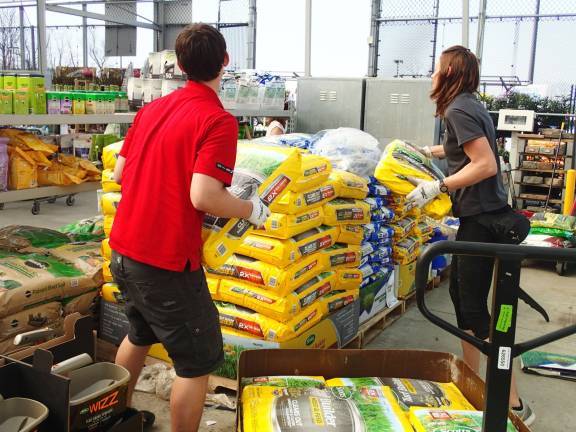
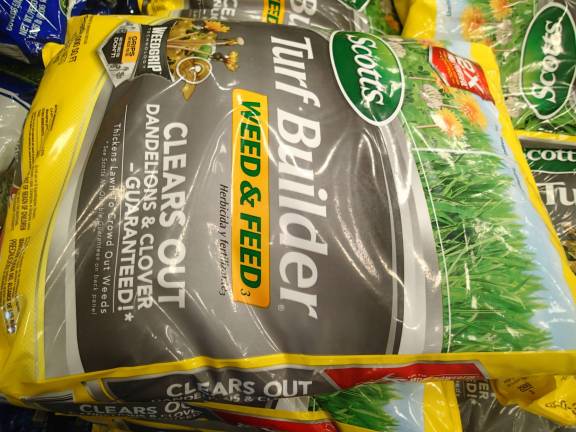
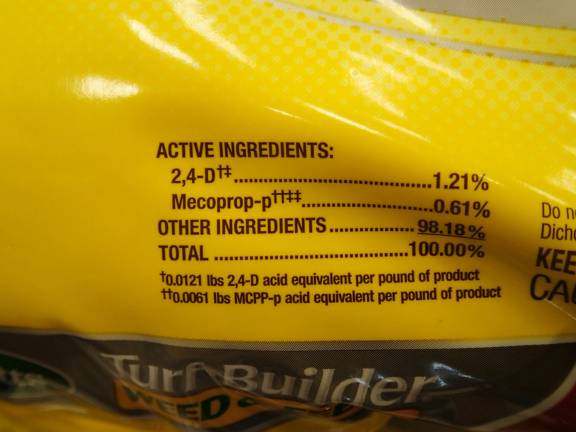
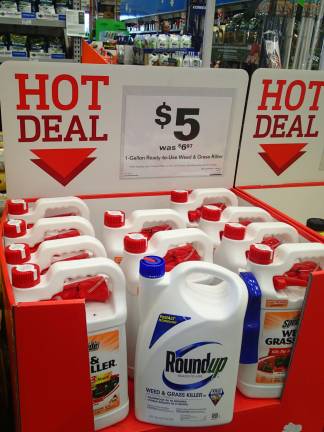
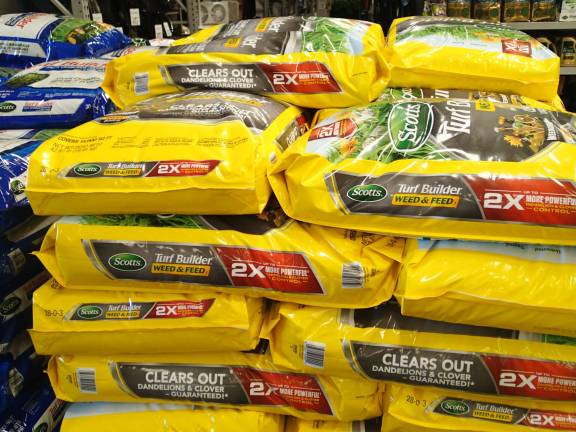
Slinging hardcore chemicals in the wild west of suburban lawn care
By Cheyenne Boccia and Becca Tucker
A lush green lawn seems like little enough to ask. It’s why we live in “the country” and not in overpriced closet-sized apartments. We want to walk outside in the morning onto a soft, cool carpet unmarred by weeds, and there are all sorts of products out there to help you keep your piece of earth the way you like it. Just walk into the hardware store and pick up a bottle of Weed B Gon Weed Killer or a bag of Turf Builder. But what’s inside that bottle, that bag?
The names of the chemicals in any given lawn product mean nothing to most of us. Take, for instance, Scotts Turf Builder Weed & Feed, guaranteed to kill dandelion and clover: active ingredients 2,4-D and Mecoprop-P. Inactive ingredients don’t have to be listed, which doesn’t make much sense since they comprise over 98 percent of what’s in the bag, but also doesn’t make much difference, since unless you’re a chemist, the ingredients might as well be in another language.
We’ll pick one chemical to focus on, to keep our heads from exploding. Let’s zoom in on 2,4-D. If you see a nice green lawn free of dandelions, chances are it’s been treated with 2,4-D.
Developed by Dow Chemical in the chemical boom during World War II, 2,4-D is one of the oldest and most widely used herbicides out there. But it’s more infamous as one of the two main ingredients in Agent Orange, the poison that U.S. fighters sprayed over Vietnam to defoliate the tropical canopy that provided enemy cover – and is now blamed for veterans’ illnesses from cancer to diabetes to spina bifida in babies born to those who’d been exposed. Most studies point to Agent Orange’s other primary ingredient, 2,4,5-T, as the culprit in making people sick, and it has been banned in the U.S. But decades of scientific studies have also found links between 2,4-D and certain types of cancers in humans as well as in dogs. Recent studies suggest that it can also cause problems with brain development, increase the risk of birth defects and lower sperm counts.
ScottsMiracle Gro says it’s safe, since 2,4-D breaks down in sunlight and rain, and bodies clear it quickly. “It’s the dose that makes the poison,” said Dr. James Bus, on a video on Scott’s website, and “no matter how this chemical is used it the environment, it can’t create doses that are even remotely close to what would approach the potential for inducing a toxic effect in a human system.” Bus is a toxicology consultant who worked for Dow Chemical Company for 24 years.
The Natural Resources Defense Council, meanwhile, called 2,4-D “the most dangerous pesticide you’ve never heard of,” in a story published last spring. Researchers have linked 2,4-D to the blood cancer non-Hodgkins lymphoma, as well as the soft-tissue cancer sarcoma. The World Health Organization has classified it as a possible carcinogen, as has the International Agency for Research on Cancer. The connections to cancer is tough to prove, because 2,4-D is usually mixed with other hardcore chemicals. The evidence is stronger that it’s an endocrine disruptor that can harm the thyroid, which is important for brain development.
The U.S. Environmental Protection Agency says that 2,4-D is “low in toxicity if eaten, inhaled, or if it contacts the skin,” but also that “dogs and cats that ate or drank products with 2,4-D in them developed vomiting, diarrhea, loss of appetite, lethargy, drooling, staggering, or convulsions.”
Got it? Neither do we.
What we do know about 2,4-D is that its use is skyrocketing on American farms since Dow AgroSciences combined it with Monsanto’s Roundup to create the boosted pesticide Enlist Duo. Enlist Duo, the chemical companies’ answer to the superweeds plaguing farmers who relied on Roundup, was approved by the Environmental Protection Agency in 2014. What we don’t know is how much of the stuff is being spread on yards, because no one keeps track of that. No one has any oversight at all over what Johnny homeowner is doing with these chemicals that may or may not make us sick.
When farmers spray pesticides, whether we agree with the practice or not, there are at least rules they have to follow. Restricted pesticides require a farmer to have a license, or go through someone who does, and to adhere to a strict schedule that determines when and where they can be used. But with any pesticide, there is protocol farmers have to follow, or risk getting in trouble. They can’t apply more than the recommended amount for their acreage. They’ve got to be wearing long sleeves and long pants.
Sure, farmers can get carried away too, doubling down on those damn dandelions, but “it has pretty good controls on it,” said Al Buckbee, of Bellvale Farm in Warwick, NY. “I guess if we decided we wanted to start selling it on the black market or something, I guess if we started to get too many pounds or too many gallons of material, a whistle or bell would go off. It’s considerably more complex than somebody wants to go down and get a bag of Weed B Gon at Home Depot or wherever and go take care of their lawn.”
You or I, on the other hand, can buy a jug of 2,4-D and mix up a batch of weed killer in shorts and sandals, go out in the yard with a coffee can, wing it around — including on the driveway, where it just drips off into the nearest waterbody — and hope for the best. Or maybe we load a bag of the stuff into an old push spreader whose rate sticker fell off years ago. When we run out, we go buy another bag.
There are detailed instructions on the bag, and a warning that says not following the label is a violation of federal law. But no one’s checking. No one even knows we bought the stuff.
If it turns out we put down down four times the labeled rate? “Nobody seems to care,” said Mat Cooper, an agronomist and licensed pesticide applicator with Crop Production Services in Goshen, NY. “If DEC [the Department of Environmental Conservation] finds out that I had done this, I would be in jail and looking at many dollars in fines.”
Applying too much of a pesticide, unsurprisingly, compounds the problems downstream, and there’s no upside: over-application doesn’t make the product work any better. It creates more runoff that pollutes drinking water, kills wildlife, and acts like steroids for the algae that can eventually choke ponds and lakes and turn them toxic. It means there’s more poison on the grass to be tracked into the house, where without sunlight and rain it can hang around for much longer than it does outside, on the floor where kids play and babies crawl.
In March, the DEC put up a cheesy video on its homepage that begins with an unrealistically young dad-type spreading a generic bag of Weed and Feed on his lawn with a push spreader, while a mom-type gives him a smile and sprays some chemical on the flowers bordering the house. Then the rain starts, and with it the scary music.
“A picture perfect lawn may look harmless, but its effects can be a real horror show,” says the voiceover. A bunch of rubber duckies grow horns and turn red, and while the couple cowers on the walkway, the devil duckies book it into a gutter, emerging through a culvert into a pristine lake, which becomes a stew of algae. “Rain washes fertilizer, bug and weed killers off your lawn, down ditches and drains and into our rivers, lakes and streams, where they can be toxic to wildlife and pollute our water. So cut back on lawn chemicals, mow higher, leave the clippings, and enjoy a beautiful, healthy, safer lawn.” But if you are going to use fertilizers (the takeaway here is sort of confusing), they suggest you look for one that doesn’t contain phosphorous, which feeds algae.
To illustrate the wild west world of suburban lawncare, here’s a snippet of an online conversation we came across on an outdoor forum:
Uncle Jack D: My neighbor let me use his 2,4-D to poison today but I’m not sure on mixing ratios and don’t wanna kill my entire yard. He told me to put 2 cups per 4 gallons. According to this [the back of the bag], it calls for way less… The guy who gave it to me used to be in the lawn business and said it worked great for weed control. The problem is, he told me 2 cups... I don’t know if he meant 2 actual cups or two of the plastic cups he gave me to pour. He’s golfing right now so I can’t get in touch with him and I wanted to get it done before the wind starts.
Homeowners could certainly do with some education on how misuse of pesticides can harm the environment, said Steve Pennings Jr., farm manager at Penning’s Farm in Warwick, NY. Still, it’s not near the top of his list of worries. “All in all, I feel it’s fine what a homeowner does since they don’t have access to products with the potency that a farmer does. I personally believe that a person’s everyday misuse of water, production of garbage, and bring of fossil fuels has much more impact on the environment.”
“Pesticide use around the home should be just as concerning as it is with farms,” said Dan Daly, of Dan’s Pro Grow in Goshen. He understands that folks want to keep their biggest investments — their home and landscape — looking nice. But he’s seeing a consciousness shift driving the majority to look for organic alternatives, just as they do at the grocery store. “We all tend to think twice about putting down poisons on the grass our children and pets play on, or on the food that we plan on eating. Having a green lawn and nice garden haven’t changed, but how we keep them looking that way has.”
Buckbee, of Bellvale Farms, has noticed a change, too. When he watches his grandkids play sports in Warwick, “you walk out on the fields and there’s lots of dandelions and not so much grass,” he said. They could straighten the fields up, Buckbee knows, and make them look really beautiful with an application of 2,4-D and a re-seeding with varieties of long grass seed. But in what looks like a hard-used soccer field he can see the evolution of a community’s shifting priorities. They’re leaving them that way, now, by choice.
The freedom lawn: dandelions are beautiful
Let your lawn express itself this growing season. Put away the mower, save time and gas money, and see who shows up. I am referring to plants here, not town authorities. Assuming you’ve totally ditched agricultural chemicals (read poison) years ago to safeguard your health and the ecosystem, your lawn will thank you and most likely sprout some of the most useful plants that are consumed for both food and medicine. (By the way, if you are not able to let the whole lawn grow wild, perhaps you can let a section do so).
I predict dandelion (Taraxacum officinale), chickweed (Stellaria media), wood sorrel (Oxalis stricta), and violet (Viola sororia) will make an appearance. Once you’ve properly identified these feral plants, you can begin to forage. All of these plants are excellent eaten raw in salad and also prepared in various ways.
The flowers of violets and dandelions can be tossed into salads, made into floral butters, or used to adorn desserts and drinks, bringing serious color and health promoting bioflavonoids to a meal. It’s important to note: dandelion blossoms also provide much needed nectar for the bees.
The leaves of chickweed, violet and wood sorrel make a tasty nutrient dense salad that is packed with vitamin C, beta-carotene, and minerals. In addition, the first two plants contain healing phytochemicals that soothe the gut and the skin. This trio also makes a great pesto that can be spread onto bread or cucumber rounds or used as a sauce on grains, pasta or vegetables.
The bitter flavored roots and leaves of dandelion are food, yet they also have a long history of use in herbal medicine. They are employed for various health issues by supporting liver and kidney function. Dandelion is an alterative, defined as a substance that helps alter the body into a healthier state. Why not dig up some dandelions and brew them into an herbal infusion (long steeped tea) or into a bitters elixir (tincture).
Imagine all these wild treasures bursting forth from your expressive lawn. Let the foraging begin.
- Dina Falconi, author of Foraging and Feasting: A Field Guide and Wild Food Cookbook, botanicalartspress.com